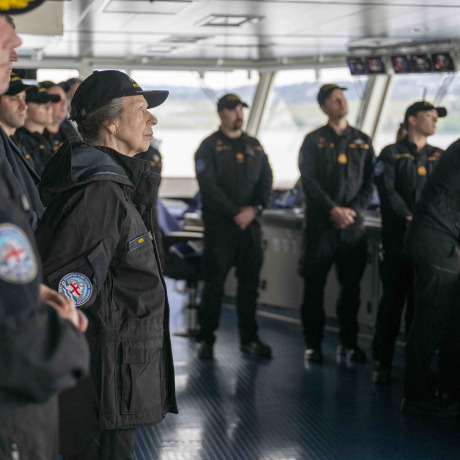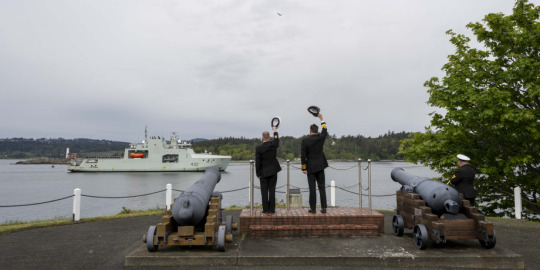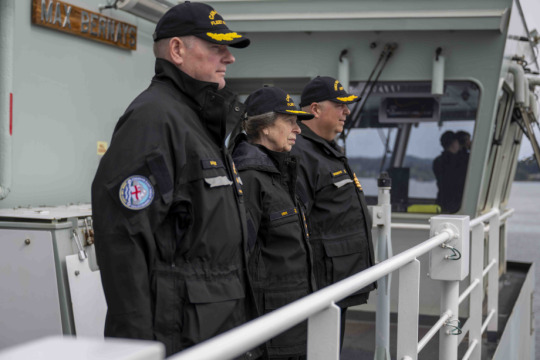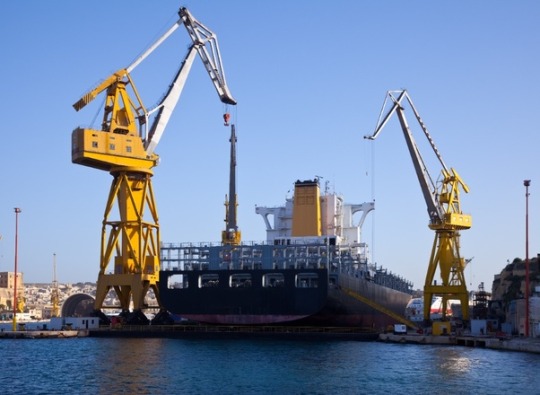#offshore supply vessel
Explore tagged Tumblr posts
Text

M/V "STRIL BARENTS"
#maritime#ships#shipping#workboat#norway#international shipping#seaworks#boats#workboats#offshore supply vessel#offshore#offshore support vessel
0 notes
Text
AM Pride
Offshore Vessel AM Pride burnt; 15 rescued off South Africa; #sa #samsa #fire
On September 12, the 66 meter long, 2018 dwt offshore supply vessel AM Pride (IMO: 9359167) caught fire some 48 nautical miles south of Mossel Bay, South Africa. The fire started in the vessel’s galley and quickly got out of control. The vessel contacted its owner who relayed the distress call to the South African Maritime Safety Authority (SAMSA). Authorities broadcasted an alert to nearby…

View On WordPress
0 notes
Text
The global Offshore Support Vessel Market is projected to reach USD 31.4 billion by 2028 from USD 22.6 billion in 2023 at a CAGR of 6.7% according to a new report by MarketsandMarkets™.
#offshore companies#offshore outsourcing#offshore services#offshore drilling#offshore#offshore oil rig#offshore support vessel market#offshore support vessel#offshore systems#offshore supply#offshore supply vessel#offshore vessels#offshore vessel#energy#oil and gas#oil and gas industry#offshore oil and gas#offshore oil#offshore pipelines#offshore platform#offshore energy#offshore wind farm#offshore wind#offshore wind power#oil and gas exploration#oil and gas companies
0 notes
Text
Delray Beach, FL, Oct. 30, 2024 (GLOBE NEWSWIRE) -- The global Offshore Support Vessel Market size is expected to grow from USD 25.6 billion in 2024 to USD 36.3 billion by 2029, at a CAGR of 7.2% according to a new report by MarketsandMarkets™. An offshore support vessel (OSV) is specially designed to support offshore exploration, drilling, production, and construction activities in the oil & gas industry. These vessels provide a range of services, such as transportation of personnel, equipment and supplies, maintenance and repair, and oil spill response. OSVs are also used for specialized tasks such as platform installation, decommissioning, seismic surveying, providing firefighting, towing, and positioning of drilling rigs and other offshore structures, and subsea construction. These vessels are equipped with dynamic positioning systems to maintain their position in rough seas and are built to withstand harsh offshore conditions. Different types of offshore support vessels are used in offshore oil & gas and offshore wind applications. OSVs play a crucial role in offshore oil & gas and offshore wind farms by enabling safe and efficient operations.
#offshore support vessel (osv)#energy#energia#offshore support vessel#offshore supply#offshore companies#offshore drilling#offshore#offshore oilwell#offshore oilfield#offshore oilrig#offshore oil and gas#offshore oil#offshore wind farms#offshore wind farm#offshore wind#Offshore support vessels#osv market#osv#oil and gas companies#oil and gas industry#oil and gas exploration#oil and gas drilling
0 notes
Text

Biden will direct the U.S. military to undertake the mission alongside allies and humanitarian partners, a senior administration official said. The project will take “a number of weeks to plan and execute” and will involve forces already in the region or that will be there soon. Senior administration officials said the project will not require any U.S. boots on the ground in Gaza. Instead, the plan involves U.S. personnel on military vessels offshore who will not be required to go ashore to install the port. Initial shipments of supplies would come via Cyprus, enabled by the U.S. military and partners. Officials said the U.S. would work with the United Nations and other humanitarian partners to distribute aid across Gaza once it reaches the port.
There are thousands of aid trucks sitting at the Egyptian border that could be allowed in instead of this ridiculous convoluted plan which means
This is an excuse to officially send in US troops into Gaza where they will help the IDF continue their genocide in the name of aiding Palestinians
"The project will take “a number of weeks to plan and execute”" meaning there is no intention of ending the genocide any time soon
The last part is most important and the one that should scare us the most given the already horrific conditions of Northern Gaza
#yemen#jerusalem#tel aviv#current events#palestine#free palestine#gaza#free gaza#news on gaza#palestine news#news update#war news#war on gaza#genocide joe#butcher biden#gaza genocide#genocide#famine#northern gaza#imperialism
6K notes
·
View notes
Link
#market research future#offshore support vessels#supply vessel spot market#offshore supply vessel market#offshore vessel charter rates
0 notes
Text
The Princess Royal visits British Columbia, Canada.

As Commodore-in-Chief of the Canadian Fleet Pacific, Her Royal Highness The Princess Royal, accompanied by Vice Admiral Sir Tim Laurence, has been in British Columbia for a series of engagements with the Royal Canadian Navy.

Upon arrival in Canada on Friday 3rd May, The Princess Royal attended the Commissioning Ceremony for the HMCS Max Bernays – the Canadian Pacific Fleet’s first Arctic and Offshore Patrol Vessel. The Princess Royal also had an opportunity to tour the ship and meet some of its company.

The following day, on Saturday 4th May, Her Royal Highness laid a wreath at God’s Acre Cemetery as President of the Commonwealth War Graves Commission. The historic cemetery, in Esquimalt, is the final resting place of more than 2,500 military personnel and their families.

Next, The Princess Royal visited the Maritime Museum of British Columbia Archive to view some of the items in its archival collection.

After learning that there was no naval museum during a visit to Esquimalt in 1951 by the then Princess Elizabeth and Prince Phillip, Prince Philip contacted the Greenwich Maritime Museum and asked them to send some objects to British Columbia to start a new naval museum thus creating the Maritime Museum of British Columbia.

The Princess Royal also visited FED Urban Farm to hear about their work in providing home-based start up food gardens during the Pandemic which used simple and affordable supplies.

On Sunday 5th May, The Princess Royal and Sir Tim Laurence attended the Battle of the Atlantic Memorial Parade. The Battle of the Atlantic was the longest continuous battle of the Second World War and the Parade commemorates the service and sacrifice of the thousands of Canadians who fought for control of the North Atlantic Ocean to supply the war effort from 1939 to 1945.

© Royal UK
#NOT EVERYTHING WAS MENTIONNED BY THESE FUCKERS#IDK WHY#UGH#princess anne#princess royal#tim laurence#timothy laurence#brf#british royal family#workanne
33 notes
·
View notes
Text
It will cost Canadian taxpayers upwards of $6.5 billion to acquire six Arctic Offshore Patrol Ships for the navy and two additional similar vessels for the coast guard, according to newly tabled documents and a statement from the federal government.
Public Services and Procurement Canada (PSPC) says a contract amendment has been signed with Irving Shipbuilding Inc. of Halifax, N.S. that allows for a top-up to the budget for the military ships and sets the contract price for the coast guard vessels.
The cost of the navy ships has now risen to $4.98 billion from an earlier projection of $4.3 billion. The contract for the coast guard vessels has been set at $1.6 billion — an increase of $100 million from the figures tabled before Parliament last spring. [...]
Both procurement services and the Department of National Defence��blame the increases on the labour shortages and supply chain issues brought on by the pandemic — factors that PSPC said have, among other things, resulted in "higher shipping costs and higher costs for spare parts."
In a media statement, PSPC said it has undertaken a thorough review of the program's projected costs and has built a contingency fund into the planning process to cover "possible cost impacts due to higher than forecasted cost of materials."
But critics say the Liberal government has not provided much oversight of the shipbuilding program writ large and that costs continue to swell each year. [...]
Continue Reading.
Tagging: @politicsofcanada
76 notes
·
View notes
Text
When turbine blades for the United States’ first offshore wind project left port in September 2023, headed for the Vineyard Wind 1 project off Massachusetts, they were traveling on a barge instead of a wind turbine installation vessel, or WTIV. These purpose-built vessels are common in other parts of the world and make the job much, much easier. A WTIV is a transportation and construction rig in one. Frequently equipped with a big crane, deployable legs, and a dynamic positioning system, WTIVs can support the installation of several humongous turbines per trip.
There are dozens of WTIVs plying the world’s waters. So, why were the Vineyard Wind 1 blades delivered on a barge? This expensive, inefficient workaround was necessary because of a century-old law known as the Jones Act.
Also known as the Merchant Marine Act of 1920, the Jones Act requires anyone transporting goods from one point in the United States to another to use an American ship. And by a modern interpretation of the old law, an offshore turbine counts as a point in the United States. The trouble is, the United States doesn’t have any WTIVs. And without the appropriate equipment, the country’s offshore wind efforts are being plagued by the need for repeated, smaller-capacity barge trips that have added costs to projects already beset by financial difficulties. Danish energy company Ørsted, for example, cited vessel delays when it canceled two planned projects off the New Jersey coast: Ocean Wind 1 and 2.
The country’s first Jones Act–compliant WTIV, the Charybdis, is currently under construction in Texas. While originally planned for completion in 2023, labor constraints have pushed the Charybdis’s launch back at least a year, possibly into 2025, says Dominion Energy, the vessel’s owner.
The Biden administration’s goal is to deploy offshore wind turbines capable of generating 30 gigawatts of power by 2030. That’s more than 2,000 turbines. To meet this target, the National Renewable Energy Laboratory (NREL), part of the US Department of Energy, says there’s a need for four to six WTIVs. But as 2030 draws ever closer, the incomplete Charybdis remains the only one.
The Jones Act is tricky to navigate. For a vessel to be compliant, it must not only be built in the United States and running the country’s flag but also be owned and crewed by Americans. Consequently, US shipyards enjoy a monopoly, which allows them to demand massively inflated prices.
When finished, the 144-meter-long Charybdis will boast over 5,000 square meters of main deck area and accommodate up to 119 people, supported by on-board cabins, mess rooms, and shops, as well as a cinema, gym, and hospital. But the WTIV’s cost has climbed from US $500 million to $625 million. Meanwhile, the major shipyards in South Korea could have built a similar vessel in less time, for less money, and with a more powerful crane.
The reason for the Jones Act’s longevity, says Colin Grabow, a research fellow at the Cato Institute, a libertarian think tank, is that while it tends to benefit only a few people and businesses, the act goes unnoticed because there are many payers sharing the increased costs.
The Jones Act is one in a string of protectionist laws—dating back to the Tariff Act of 1789—designed to bolster US marine industries. The Jones Act’s existence was meant to ensure a ready supply of ships and mariners in case of war. Its authors reasoned that protection from foreign competition would foster that.
“Your average American has no idea that the Jones Act even exists,” Grabow says. “It’s not life-changing for very many people,” he adds. But “all Americans are hurt by the Jones Act.” In this case, that’s by slowing down the United States�� ability to hit its own wind power targets.
Grabow says those most vocal about the law—the people who build, operate, or serve on compliant ships—usually want to keep it in place.
Of course, there’s more going on with the country’s slow rollout of offshore wind power than just a century-old shipping law. It took a slew of factors to sink New Jersey’s planned Ocean Wind installations, says Abraham Silverman, an expert on renewable energy at Columbia University in New York.
Ultimately, says Silverman, rising interest rates, inflation, and other macroeconomic factors caught New Jersey’s projects at their most vulnerable stage, inflating the construction costs after Ørsted had already locked in its financing.
Despite the setbacks, the potential for offshore wind power generation in the United States is massive. The NREL estimates that fixed-bottom offshore wind farms in the country could theoretically generate some 1,500 gigawatts of power—more than the United States is capable of generating today.
There’s a lot the United States can do to make its expansion into offshore wind more efficient. And that’s where the focus needs to be right now, says Matthew Shields, an engineer at NREL specializing in the economics and technology of wind energy.
“Whether we build 15 or 20 or 25 gigawatts of offshore wind by 2030, that probably doesn’t move the needle that much from a climate perspective,” says Shields. But if building those first few turbines sets the country up to then build 100 or 200 gigawatts of offshore wind capacity by 2050, he says, then that makes a difference. “If we have ironed out all these issues and we feel good about our sustainable development moving forward, to me, I think that’s a real win.”
But today, some of the offshore wind industry’s issues stem, inescapably, from the Jones Act. Those inefficiencies mean lost dollars and, perhaps more importantly in the rush toward carbon neutrality, lost time.
6 notes
·
View notes
Text

Platform Supply Vessel (PSV) equipped with Dynamic Positioning (DP)System
#maritime#shipping#ships#norway#seaworks#Offshore Supply Vessel#Platform Supply Vessel#PSV#Dynamic Positioning#DP#DP2#Brunvoll
0 notes
Text
Brazil expected to demand more hybrid-propulsion offshore vessels

Brazil is expected to see an increase in the demand for hybrid-propulsion offshore support vessels in its oil and gas sector in the coming years to reduce diesel consumption and CO2 emissions.
That is what Marcelo Martins, technical commercial director of shipowner Companhia Brasileira Offshore (CBO), told BNamericas.
In 2022, the company signed a contract with Equinor to convert three platform supply vessels (PSVs) to use both stored electricity and diesel.
The expectation is that there will be a significant reduction in the use of diesel and, consequently, a decrease of up to 40% in the ships' CO2 emissions.
Continue reading.
#brazil#politics#brazilian politics#economy#oil industry#mod nise da silveira#image description in alt
2 notes
·
View notes
Text
Jun 05, 2023 (AB Digital via COMTEX) -- The global Offshore Support Vessel Market is projected to reach USD 31.4 billion by 2028 from USD 22.6 billion in 2023 at a CAGR of 6.7% according...
#offshore supply vessel#offshore supply#offshore support vessel#offshore support vessel market#offshore companies#offshore outsourcing#offshore services#offshore drilling#offshore#offshore oil rig#offshore oil and gas#offshore oil#offshore pipelines#offshore platform#offshore drilling rigs#offshore decommissioning#offshore rig#offshore energy#offshore vessels#offshore vessel#marine#maritime#offshore exploration
1 note
·
View note
Text
The global Offshore Support Vessel Market in terms of revenue was estimated to be worth $25.6 billion in 2024 and is poised to reach $36.3 billion by 2029, growing at a CAGR of 7.2% from 2024 to 2029 according to a new report by MarketsandMarkets™. The global Offshore Support Vessel Market is anticipated to grow at a higher level. There are various drivers responsible for the growth of the market such as government policies and incentives and technological advancements among others. The rising global demand for energy, particularly from developing countries, pushes the need for increased offshore exploration and production, subsequently driving the OSV market.
#offshore support vessel (osv)#offshore support vessel#offshore supply#offshore vessel#energy#energia#power generation#renewable power#electricity#renewableenergy#renewable resources#offshore decommissioning#offshore wind#offshore drilling#offshore outsourcing#offshore#Offshore companies#offshore oilwell#offshore oilfield#offshore oilrig#offshore oil and gas#offshore oil#Offshore drilling#oilfields#oil industry#oil and gas companies#oil and gas#oil#offshore wind farms#offshore wind farm
0 notes
Text
Why Hamworthy Air Compressors are a Trusted Choice in the Maritime Industry?
In the maritime industry, reliability, efficiency, and durability are paramount when it comes to the equipment that powers a ship's operations. One of the most critical pieces of machinery on board is the air compressor—a vital component that ensures smooth functioning of everything from engine starters to pneumatic tools and cargo systems. Among the leading names in air compressor technology, Hamworthy Air Compressors stand out as a trusted choice for maritime applications. With a legacy of providing robust, high-performance solutions, Hamworthy compressors have earned a reputation for excellence in the demanding environment of the maritime industry.

1. Proven Track Record of Reliability
One of the key reasons Hamworthy air compressors are a trusted choice in the maritime industry is their proven reliability. Ships are often at sea for extended periods, and downtime can result in costly delays and operational setbacks. Hamworthy compressors are designed to withstand the harsh conditions of marine environments, including exposure to saltwater, extreme temperatures, and constant vibrations.
Engineered with high-quality materials and advanced technology, these compressors provide continuous performance without the risk of failure. This reliability ensures that critical ship systems—such as engine starting systems, cargo handling, and pressurized air for tools—continue to function smoothly, minimizing the risk of unexpected maintenance or breakdowns. This level of dependability is crucial for keeping ships running efficiently and safely.
2. Energy Efficiency and Cost Savings
Another reason Hamworthy air compressors are widely preferred in the maritime industry is their exceptional energy efficiency. As fuel costs continue to rise and the push for sustainability becomes stronger, ships are under increasing pressure to reduce energy consumption and operating expenses. Hamworthy compressors are designed with energy-saving features that help lower fuel consumption and reduce overall operational costs.
By optimizing compressed air generation and minimizing energy losses, Hamworthy air compressors reduce the amount of energy required to maintain the required air pressure for ship systems. This results in cost savings in the long term, particularly for vessels that operate over long distances or have high-demand air systems. The energy efficiency of Hamworthy compressors also aligns with the maritime industry's growing focus on reducing emissions and minimizing environmental impact.
3. Durability and Longevity
Hamworthy air compressors are built to last. The maritime industry demands equipment that can handle tough conditions and maintain high performance over time. Hamworthy compressors are crafted with durability in mind, using corrosion-resistant materials and heavy-duty components that can endure the wear and tear of continuous use.
Their robust construction ensures that these compressors require minimal maintenance and experience fewer breakdowns, even in harsh maritime environments. This durability translates into lower maintenance costs and longer intervals between repairs, which is a significant advantage for ship owners and operators who want to keep their vessels running efficiently without the burden of frequent maintenance.
4. Versatility for Various Marine Applications
Hamworthy air compressors are designed to serve a wide range of applications, making them a versatile choice for many different types of vessels. Whether it’s a cargo ship, tanker, offshore platform, or passenger cruise liner, Hamworthy compressors can be customized to meet the specific needs of any shipboard operation.
The compressors are used for a variety of vital functions, including starting marine engines, supplying air for pneumatic systems, controlling cargo systems, and supporting ventilation. Their adaptability means that Hamworthy compressors can provide a reliable air supply across multiple systems, reducing the need for different compressors for each application and simplifying shipboard operations.
5. Advanced Technology and Innovation
Hamworthy is committed to staying at the forefront of compressor technology, constantly improving the performance and features of their products to meet the evolving demands of the maritime industry. With innovations in energy efficiency, noise reduction, and system integration, Hamworthy air compressors offer advanced capabilities that improve overall ship performance.
For instance, Hamworthy’s compressors are equipped with smart control systems that monitor and adjust air pressure levels in real-time, ensuring that the ship's systems are always running at optimal conditions. These technological advancements enhance the overall efficiency of ship operations, providing further value to ship owners, operators, and engineers.
6. Strong Support Network and After-Sales Service
When it comes to maintaining and servicing critical equipment like air compressors, having a reliable support network is essential. Hamworthy provides excellent after-sales support, including routine maintenance, technical assistance, and repair services. Their team of experienced technicians ensures that any issues are quickly resolved, minimizing downtime and maximizing the operational lifespan of the compressors.
The brand’s strong presence in the maritime industry, coupled with their global service network, ensures that ship operators have access to timely and efficient support, no matter where they are operating.
Conclusion
Hamworthy air compressors have become a trusted choice in the maritime industry due to their reliability, energy efficiency, durability, versatility, and innovative technology. With their ability to handle the demanding conditions of the sea and deliver consistent performance, Hamworthy compressors are integral to the efficient operation of ships worldwide. Whether for engine starting, cargo handling, or other vital systems, Hamworthy air compressors provide ship operators with peace of mind, knowing that their equipment is built to last and operate effectively in all conditions.
By investing in a Hamworthy air compressor, ship owners and operators can reduce operational costs, improve energy efficiency, and ensure the longevity of their vessels—making them a wise choice for any maritime operation.
0 notes